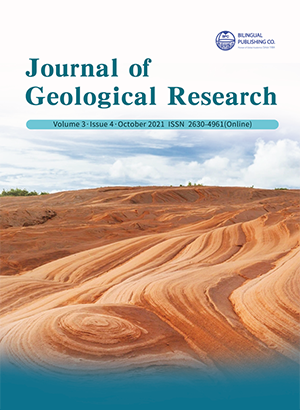Interpretation of Aeromagnetic Data of Part of Gwagwalada Abuja Nigeria for Potential Mineral Targets
DOI:
https://doi.org/10.30564/jgr.v3i4.3581Abstract
This study analyzes aeromagnetic data over a section of Gwagwalada in Abuja. The data were obtained from the Nigerian Geological Survey Agency acquired at 100 m terrain clearance. The study area spans longitudes 7.0875 E to 7.1458 E and latitude 8.9625 N to 9.0 N (about 27 km2). The dataset was reduced to the equator (RTE) and downward continued by 50 m. Analytic signal filter was applied on TMI-RTE grid to detect the edges of the magnetic bodies present. The structure was observed to trend NE-SW. The CET lineament map reveals intersections such as junctions and corners on the map. This revealed structure liable for potential mineralization zone. Euler deconvolution technique applied over the transformed dataset ascertain the location and depth of the structure,having a maximum depth of about 421 m and a minimum of about 59 m.Variation in magnetic depth and susceptibility contrast is specified by the gridded SPI depth map.
Keywords:
Aeromagnetic; Lineament; Faults; Total magnetic intensityReferences
[1] Elkhateeb, O.S. Delineation Potential Gold Mineralization Zone in A Part of Central Eastern Desert,Egypt Using Airborn Magnetic and Radiometric data [J]. NRIAG Journal of Astronomy and Geophysics (2018). 55-70.
[2] Finlay C.C, Maus S, Beggan C.D, Bondar T.N,Chambodut A, Chernova T.A, Chulliat A, Golovkov V.P, Hamilton B, Hamoudi M, Holme R. International geomagnetic reference field: the eleventh generation [J]. Geophysical Journal International (2010).183(3):1216-30.
[3] Hinze W.J. The role of gravity and magnetic methods in engineering and environmental studies. InGeotechnical an Environmental Geophysics: Volume I:Review and Tutorial [J]. Society of Exploration Geophysicists (1990). 75-126.
[4] Kearey, P, Brooks, M., & Ian, H. An Introduction to Geophyscial Exploration. Third Edition Blackwell Publishing (2002).
[5] Mushayandebvu M.F, Lesur V, Reid A.B, Fairhead J.D. Grid Euler deconvolution with constraints for 2D structures [J]. Geophysics (2004). 69(2):489-96.
[6] Nabighian, M. N. The analytic signal of two-dimensional magnetic bodies with polygonal cross-section- Its properties and use for automated anomaly interpretation [J]. Geophysics (1972), 37, 507-517.
[7] Nabighian, M. N. Additional comments on the analytic signal of two-dimensional magnetic bodies with polygonal cross-section [J] Geophysics (1974), 39,85-92.
[8] Offodile, M. E. The development and management of groundwater in Nigeria. Contributions of Geosciences and Mining to National Development, (NMGS) (2003), 1-7.
[9] Reid, A.B., Allsop, J.M., Granser, H., Millett, A.J.,Somerton, I.W. Magnetic Interpretation in Three Dimension Using Euler Deconvolution [J]. Geophysics (1990), 55, 80-90.
[10] Reynolds, R.L., Rosenbaum, J.G., Hudson, M.R and Fishman, N.S Rock Magnetism, the istribution of Magnetic Minerals in Earth Crust and Aeromagnetic Anomalies. U.S Geological Survey Bulletin (1990).24-45.
[11] Robert, J.H. Application of Magnetic and Electro magnetic Methods to Locate Buried Metal. U.S Department of Interior, U.S Geological Survey, Open File Report (2003). 03-317.
[12] Roest, W.R., Verhoef, J., and Pilkington, M. Magnet ic interpretation using the 3-D analytic signal. Geophysics (1992), 57, 116-125.
[13] Scott, W.J Geophysics for Mineral Exploration-A Manual for Prospectors (2014). 1-2, 11-14.
[14] Smith, R.S., Thurston, J.B., Dai, Ting-Fan, and Ma cLeod, I.N. SPI™ - the improved source parameter imaging method: Geophysical Prospecting (1998),46, 141-151.
[15] Stavrev, P. and Reid, A. Degrees of Homogeneity of Potential Fields and Structural Indices of Euler De convolution [J]. Geophysics (2007), 72, 1-12.
[16] Thompson, D.T. A New Technique of Making Computer Assisted Depth Estimates from Magnetic Data [J]. Geophysics (1982), 47: 31-37.
[17] Thurston, J. B., Smith, R. S. and Guillon, J-C. A mul timodel method for depth estimation from magnetic data [J]. Geophysics (2002), 67, 555-561.
[18] Thurston, J., Guillon, J. -C. and Smith, R. Model-in dependent depth estimation with the SPI™ method:SEG Expanded Abstracts (1999), 18,403-406.
[19] Thurston, J.B., and Smith, R.S. Automatic conversion of magnetic data to depth, dip, and susceptibility contrast using the SPI™ method: Geophysics (1997),62, 807-813.
Downloads
How to Cite
Issue
Article Type
License
Copyright © 2021 Priscillia Egbelehulu, Abu Mallam, Abel. U. Osagie

This is an open access article under the Creative Commons Attribution-NonCommercial 4.0 International (CC BY-NC 4.0) License.
Copyright and Licensing
The authors shall retain the copyright of their work but allow the Publisher to publish, copy, distribute, and convey the work.
Journal of Geological Research publishes accepted manuscripts under Creative Commons Attribution-NonCommercial 4.0 International License (CC BY-NC 4.0). Authors who submit their papers for publication by Journal of Geological Research agree to have the CC BY-NC 4.0 license applied to their work, and that anyone is allowed to reuse the article or part of it free of charge for non-commercial use. As long as you follow the license terms and original source is properly cited, anyone may copy, redistribute the material in any medium or format, remix, transform, and build upon the material.
License Policy for Reuse of Third-Party Materials
If a manuscript submitted to the journal contains the materials which are held in copyright by a third-party, authors are responsible for obtaining permissions from the copyright holder to reuse or republish any previously published figures, illustrations, charts, tables, photographs, and text excerpts, etc. When submitting a manuscript, official written proof of permission must be provided and clearly stated in the cover letter.
The editorial office of the journal has the right to reject/retract articles that reuse third-party materials without permission.
Journal Policies on Data Sharing
We encourage authors to share articles published in our journal to other data platforms, but only if it is noted that it has been published in this journal.




 Priscillia Egbelehulu
Priscillia Egbelehulu

